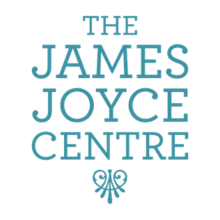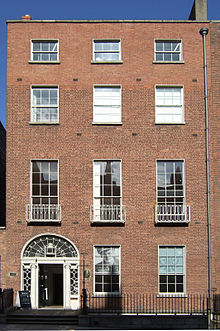
Dublin is the capital and largest city of Ireland. On a bay at the mouth of the River Liffey, it is in the province of Leinster, bordered on the south by the Dublin Mountains, a part of the Wicklow Mountains range. At the 2022 census, the city council area had a population of 592,713, while Dublin City and its suburbs had a population of 1,263,219, and County Dublin had a population of 1,501,500.

Ballsbridge is an affluent neighbourhood of the city of Dublin, the capital of Ireland. The area is largely situated north and west of a three-arch stone bridge across the River Dodder, on the south side of the city. The sign on the bridge still proclaims it as "Ball's Bridge", in recognition of the fact that the original bridge on that location was built and owned by the Ball family, a well-known Dublin merchant family in the 1500s and the 1600s. The current bridge was built in 1791.

Ulysses is a modernist novel by Irish writer James Joyce. Parts of it were first serialized in the American journal The Little Review from March 1918 to December 1920, and the entire work was published in Paris by Sylvia Beach on 2 February 1922, Joyce's fortieth birthday. It is considered one of the most important works of modernist literature and has been called "a demonstration and summation of the entire movement." According to Declan Kiberd, "Before Joyce, no writer of fiction had so foregrounded the process of thinking."

Galway is a city in the West of Ireland, in the province of Connacht, which is the county town of County Galway. It lies on the River Corrib between Lough Corrib and Galway Bay. It is the most populous settlement in the province of Connacht, the fifth most populous city on the island of Ireland and the fourth most populous in the Republic of Ireland, with a population at the 2022 census of 85,910.

Leopold Bloom is the fictional protagonist and hero of James Joyce's 1922 novel Ulysses. His peregrinations and encounters in Dublin on 16 June 1904 mirror, on a more mundane and intimate scale, those of Ulysses/Odysseus in Homer's epic poem: The Odyssey.

The General Post Office is the former headquarters of An Post — the Irish Post Office. It remains its registered office and the principal post office of Dublin — the capital city of Ireland — and is situated in the centre of O'Connell Street, the city's main thoroughfare. It is one of Ireland's most famous buildings, not least because it served as the headquarters of the leaders of the Easter Rising against British rule in Ireland. It was the last great Georgian public building to be erected in the capital.

Bloomsday is a commemoration and celebration of the life of Irish writer James Joyce, observed annually in Dublin and elsewhere on 16 June, the day his 1922 novel Ulysses takes place on a Thursday in 1904, the date of his first sexual encounter with his wife-to-be, Nora Barnacle, and named after its protagonist Leopold Bloom.

Enniscorthy is the second-largest town in County Wexford, Ireland. The town is located on the picturesque River Slaney and in close proximity to the Blackstairs Mountains and Ireland's longest beach, Curracloe.

Nora Barnacle was the muse and wife of Irish author James Joyce. Barnacle and Joyce had their first romantic outing in 1904 on a date celebrated worldwide as "Bloomsday" after his modernist novel Ulysses. Barnacle did not, however, enjoy the novel. Their sexually explicit letters have aroused much curiosity, especially as Joyce normally disapproved of coarse language, and they fetch high prices at auction. In 2004, an erotic letter from Joyce to Barnacle sold at Sotheby's for £240,800.

Sandycove is a suburb of Dublin, Ireland. It is southeast of Dún Laoghaire and Glasthule, and northwest of Dalkey. It is a popular seaside resort and is well known for its bathing place, the Forty Foot, which in the past was reserved for men only but is now available for mixed bathing. The locale features in the opening of Ulysses by James Joyce.
Events in the year 1904 in Ireland.

The Dublin Writers Museum was a museum of literary history in Dublin, Ireland. It opened in November 1991, closed during the Covid-19 pandemic, and was brought to an end in 2022 without ever reopening.
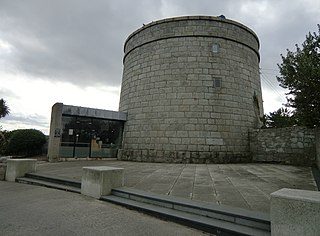
The James Joyce Tower and Museum is a Martello tower in Sandycove, Dublin, where James Joyce spent six nights in 1904. The opening scenes of his 1922 novel Ulysses take place here, and the tower is a place of pilgrimage for Joyce enthusiasts, especially on Bloomsday. Admission is free.

Tourism in the Republic of Ireland is one of the biggest contributors to the economy of Ireland, with 9.0 million people visiting the country in 2017, about 1.8 times Ireland's population. Each year about €5.2bn in revenue is made from economic activities directly related to tourists, accounting for nearly 2% of GNP and employing over 200,000 people. In 2011 alone, Ireland was voted 'Favourite holiday destination in the World' by readers of Frommer's Guide, Lonely Planet listed Ireland as the world's friendliest country and Cork City as one of the top ten cities in the world and the Irish tourist boards website, DiscoverIreland.com, was named the best tourist board website in the world. Most tourists visiting Ireland come from the United Kingdom, the United States, Germany and France.

Gerald Davis was one of Ireland's leading semi-abstract artists. He was also an art gallery owner, critic, and Joycean scholar. He was a prominent member of the Jewish community in Ireland. He wrote for Irish national newspapers and broadcast on radio and television, where he reported on the arts and Irish Jewish life.

The Dublin quays refers to the two roadways and quays that run along the north and south banks of the River Liffey in Dublin, Ireland. The stretches of the two continuous streets have several different names. However, all but two of the names share the same "quay" designation. The quays have played an important part in Dublin's history.
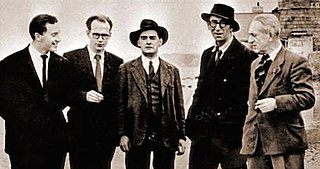
John Ryan (1925–1992) was an Irish artist, broadcaster, publisher, critic, editor, and publican.
Stephen James Joyce was the grandson of James Joyce and the executor of Joyce's literary estate.

The Museum of Literature Ireland, branded MoLI in an homage to Molly Bloom, is a literary museum in Dublin, Ireland. It opened in September 2019. The museum is a partnership between the National Library of Ireland and University College Dublin (UCD). It is located in UCD's Newman House in St Stephen's Green. It holds a permanent collection of James Joyce–related material, including his "Copy No. 1" of Ulysses, and revolving exhibitions on other Irish literary figures. With a range of audio and immersive displays, it has been nominated for and won a number of awards for design and architecture.
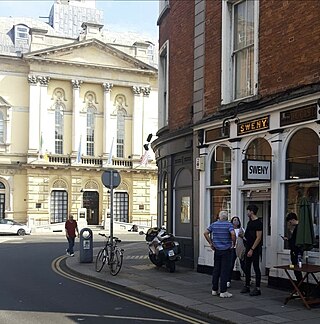
Sweny's Pharmacy, or F. W. Sweny & Co. Ltd. is a former Victorian-era pharmacy, now a used-book store, in Dublin, Ireland most notable for appearing in James Joyce's 1922 novel Ulysses. The pharmacy is one of many Joycean landmarks scattered throughout Dublin, and has become a literary tourist attraction, particularly on Bloomsday when fans of Joyce visit the premises to celebrate the book.
